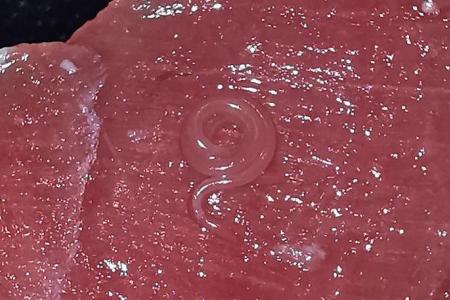How common are parasites and bugs in our food?
A woman was enjoying her sashimi rice bowl from Japanese speciality store Don Don Donki recently when she found a nasty surprise in the raw fish – a translucent, wriggling worm.
It is likely to be anisakis, a parasitic worm that, if ingested, can cause an infection with symptoms such as abdominal pain, nausea, vomiting and diarrhoea.
A spokesman for the chain store said that while it has done its best to get rid of the parasites, they may not be removed entirely if they are deeply embedded in the flesh.
The Straits Times looks at how prevalent such parasites are.
Q: How common are parasitic worms in raw fish like sashimi?
A Don Don Donki spokesman said it is common to find parasites in wild-caught fresh fish and seafood. Advisories have been placed near product displays at the chain’s outlets to inform consumers that anisakis might be present in seafood such as mackerel, sardine and squid.
According to a 2020 study by the University of Washington, there has been a 283-fold increase in anisakis globally since the 1970s. While the researchers are not entirely sure of the cause of the surge, they think that climate change, more nutrients from fertilisers and run-off, and an increase in marine mammal populations are some of the possible reasons.
Q: Is it safe to consume raw fish?
The Singapore Food Agency said ready-to-eat raw fish is considered a high-risk food as there is no cooking, which usually kills organisms. Those who eat raw fish could contract parasitic diseases.
The agency said that food that is more susceptible to food-borne diseases is tested for a wide range of hazards, including microbial pathogens and parasites, a practice that is consistent with international standards.
As a general precaution, vulnerable people with lower immunity, such as pregnant women, children and the elderly, or people with chronic diseases such as diabetes should not consume raw fish.
Q: What other organisms are commonly found in food?
One common organism found in food in Singapore are rice weevils. They are a type of beetle most often found in rice, but also can be seen in other stored grain products such as corn, millet, wheat, sorghum, oats and barley.
These insects can be found in crops in the field before they are harvested and processed, and enter homes when they are bought by consumers.
The weevils feed on the internal portions of grains, and can be detected when round holes in grain kernels are spotted, or when the grains feel damp.
The weevils can be removed by washing the rice, which is safe to consume after that. According to the SFA, food authorities usually regard rice weevils as natural and unavoidable substances that do not pose any health hazard.
Store uncooked rice properly in a tightly sealed container and in a cool and dry place. Open rice packs only when there’s a need to, and finish the opened pack within a month.
Q: What about unintended by-products such as insect fragments?
Singapore does not allow pests in food.
But in the United States, its Food and Drug Administration (FDA) says that some level of insect fragments and their excrement is unavoidable. This is because it is economically impractical to grow, harvest or process raw products that are totally free of non-hazardous, naturally occurring defects.
The FDA has set standards for the amount of such by-products allowed.
For example, the FDA allows for an average of 30 or more insect fragments per 100g, or an average of one or more rodent hair in peanut butter. Pizza tomato paste is allowed to have an average of 30 or more fly eggs per 100g.
Q: How about contaminants? What is allowed in Singapore?
The process of food production, including manufacturing, treatment, packaging, transportation or storage, may sometimes result in contaminants that end up in food. Also known as incidental constituents, the SFA has set a limit on the permissible amount of these substances in food.
For example, items such as cup noodles, fruit juice cordial and powdered beverages cannot have more than 10,000 colony forming units per gram of the bacteria family Enterobacteriaceae, which includes pathogens such as Salmonella and E. coli.
Get The New Paper on your phone with the free TNP app. Download from the Apple App Store or Google Play Store now


